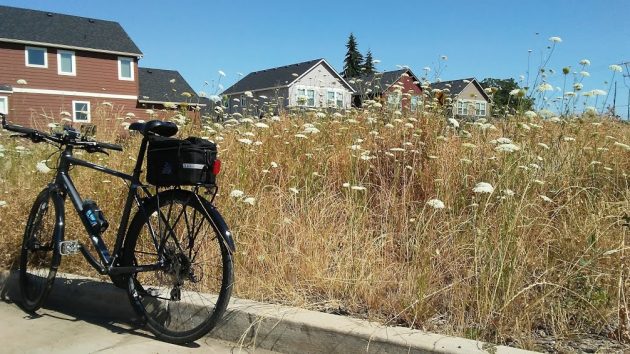
Ten inches is supposed to be the city’s limit, but these city-owned weeds were taller on July 22.
The city of Albany has a law that says grass and weeds are a public nuisance when they are more than 10 inches tall. Well, I was wondering, what about the vegetation on this city-owned vacant lot?
On its website, the city administration says that when it gets complaints about tall grass, it sends property owners a notice giving them two weeks to take care of it. If nothing is done, the city may have the place mowed and send the owner a bill.
In past summers, the city would send out a press release reminding people of the tall-grass regulations. But that was before the corona crisis, which this year may have pushed tall grass way to the bottom of anybody’s priority list.
I took the photo at the top last Wednesday. The lot is in the middle of the Edgewater Village housing development. The city obtained the property from the BNSF railroad a few years ago but hasn’t done anything with it.
During the construction of Edgewater, the lot served as the Baldwin company’s construction yard, and part of it is still covered with a layer of crushed rock. But as you can see, the rest of it has become a wild display of Queen Anne’s Lace and other plants.
So no, this is not a complaint about tall weeds. On the contrary.
The city ordinance makes an exception. Tall vegetation is not a nuisance when it’s part of agriculture. They should add another exception: It’s not a nuisance when, like in this spot, it causes no problems but serves as a haven for bees and other pollinators, which in our growing cities need all the help they can get. (hh)

Is that a bee? Can’t tell, but it’s a pollinator at work.



Leadership 101 – When it comes to regulating the behavior of residents, city officials should be the first to comply with their own ordinances.
One more bit of evidence that hypocrisy and double standards are the norm at city hall.
I was wondering about the tall weeds too, out towards Knox Butte there are many spots that are taller than 10”.
Doesn’t the city have a right of way that they should maintain? I can see so many places go up in flames.
Those are native. I hope they are not removed. They are not on the State ODA noxious weed list and in contrary, they are important pollinator plants. The alternative is about 50 noxious weeds that could come in, once this area is disturbed.
I knew these plants as Queen Anne’s Lace as a child and considered them a wild flower. Unfortunately for me, as a seed farmer, if they occur in my seed test they fall into the weed column where we know them as “Wild Carrot”. Originally from Europe, they have “naturalized,” kind of like undocumented immigrants.
When I finished military and college and came back to the farm, and was purchasing my first acreage (thank you Oregon Veterans Farm and Home Loans) I lost 10 cents a pound on my crop because in an intensive “Sod Quality” test the analyst found one wild carrot seed.
They are invasive and I now consider them definitively a weed.
This is perhaps the first time I have seen a metaphor drawn between invasive weeds from Europe and “undocumented immigrants” from Europe (via the Mayflower, Niña, Pinta, Santa Maria, etc.). It is indeed a very interesting and thought-provoking comparison; thank you for sharing.
“Many places go up in flames”! No problem at City Hall D.F., they’ll just pluck away on their harps ala Nero. OOO, D.F. don’t you realize Albany is in a budget ciris. They have a tractor but no gas to run it.
Marilyn Smith recently retired as the city’s public information officer, but in response to this story she sent this anyway: “The City of Albany no longer sends an annual news release about overgrown vegetation because the 10-inch rule applies year-round. Before the law was changed a few years ago, the offending grass and weeds had to present a fire hazard and that only applied during a declared fire season. The City does take care of its own overgrown properties as time allows and, as with private properties, in response to complaints.”